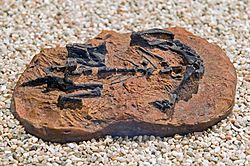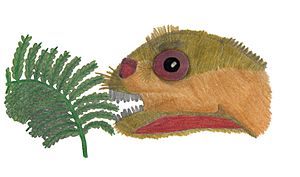Mussaurus facts for kids
Quick facts for kids MussaurusTemporal range: Upper Triassic
|
|
|---|---|
 |
|
| Fossil juvenile skeleton | |
| Scientific classification | |
| Kingdom: | |
| Phylum: | |
| Class: | |
| Superorder: | |
| Order: | |
| Suborder: | |
| Infraorder: | |
| Genus: |
Mussaurus
|
Mussaurus was an early dinosaur that ate plants. Its name means "mouse lizard." This is because the first skeletons found were very tiny, like baby mice!
This dinosaur lived about 215 million years ago. That was during a time called the Upper Triassic period. Scientists found Mussaurus fossils in southern Argentina.
When they first found Mussaurus, they only had skeletons of babies. These baby dinosaurs were very small, only about 9 to 16 inches (18 to 37 cm) long. They had big eyes, too! These were some of the smallest dinosaur skeletons ever found.
Contents
Discovering the Mussaurus
Scientists first found Mussaurus fossils in 1979. They were found in the Laguna Colorada Formation in Argentina. At first, only baby skeletons and eggs were discovered. This is why the dinosaur got its name, meaning "mouse lizard."
What Mussaurus Looked Like
Even though its name means "mouse lizard," adult Mussaurus were much bigger than mice! They could grow up to 3 meters (10 feet) long. That's about the length of a small car! They weighed around 70 kilograms (150 pounds).
Mussaurus was a type of prosauropod dinosaur. Prosauropods were early plant-eating dinosaurs. They walked on two legs, but could also walk on four. Mussaurus had a long neck and tail. Its teeth were good for eating plants.
Mussaurus and Sauropods
Scientists believe Mussaurus might be closely related to sauropod dinosaurs. Sauropods were the really huge, long-necked dinosaurs like Brontosaurus and Diplodocus. Mussaurus had some body features that suggest it was an early relative. It might even show how prosauropods slowly changed into the giant sauropods.
Images for kids
See also
 In Spanish: Mussaurus patagonicus para niños
In Spanish: Mussaurus patagonicus para niños



